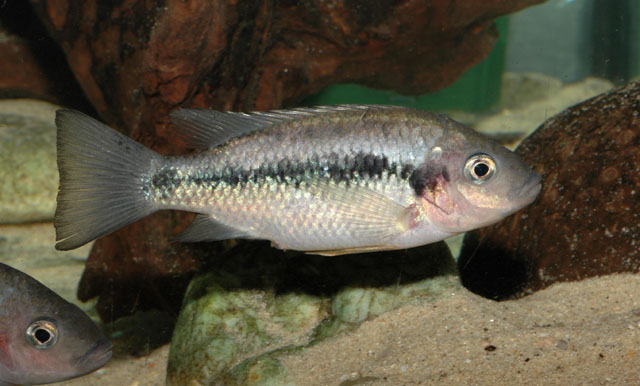| Cichlidae (Cichlids), subfamily: Pseudocrenilabrinae |
| 16.2 cm SL (male/unsexed) |
|
demersal; freshwater |
| Africa: Lake Barombi Mbo (Ref. 4999, 81260), a tributary of the Kake River (affluent of Lake Barombi Mbo) (Ref. 81260) and Kumba stream (tributary of the outlet of Barombi Mbo) (Ref. 4999), in west Cameroon. |
|
Dorsal spines (total): 15-17; Dorsal soft rays (total): 10-12; Anal spines: 3-3; Anal soft rays: 8-10; Vertebrae: 29. Diagnosis: 14-18 rakers on lower limb of first arch; 30-31 scales in lateral line (Ref. 81260). Body silver-grey, with mid-lateral black band interrupted anteriorly on caudal peduncle (Ref. 2, 81260). Head length 33.0-38.4% of standard length; jaw teeth with slender shafts and broad crowns (Ref. 81260). Mature fishes of both sexes with variable black areas on lower jaw and lower parts of head; no tilapia-mark (Ref. 2).
Description: lower pharyngeal jaw with unicuspid anterior and posterior teeth; ventral keel elongate longer than, or as long as, dentigerous plate; 4-7 rows of teeth in oral jaws, outer row teeth bicuspid (Ref. 81260).
Coloration: silvery grey (Ref. 2, 81260), with a mid-lateral black band extending from opercle to caudal fin base (Ref. 2, 52307, 81260), often interrupted anteriorly on caudal peduncle (Ref. 2, 81260). Adults may have black spots or blotches on lower jaw and/or preopercle; body of juveniles pearly; pelvics and anterior part of anal fin tinted with vermillion or orange (Ref. 81260). No "tilapia" spot present (Ref. 2, 81260). Black spot often present at origin of caudal fin (Ref. 52307). |
| Found throughout the lake, but seems to prefer zones with submerged wooden or stone structures (Ref. 52307). Usually forms schools at the surface; feeds mainly on epiphytic and epilithic filamentous algae, and the diatoms, rhizopods, rotifers and organic debris found among them; adults feed by opening their mouths very wide and applying them to the surface of the rock as though sucking the material in (Ref. 2). Lacks marked sexual dichromatism when sexually active (Ref. 81260). Both sexes are possible incubators (Ref. 52307). Forms temporary pair bonds (Ref. 81260), for the entire duration of incubation/broodcare (Ref. 52307). |
|
Critically Endangered (CR); Date assessed: 16 February 2009 (B1ab(iii)+2ab(iii)) Ref. (130435)
|
| harmless |
Source and more info: www.fishbase.org. For personal, classroom, and other internal use only. Not for publication.
